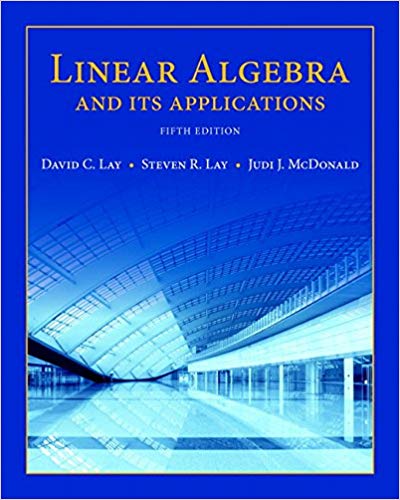
Linear Algebra and Its Applications, 5th Edition
Authors: David C. Lay, Steven R. Lay, Judi J. McDonald
ISBN-13: 978-0321982384
We have solutions for your book!
See our solution for Question 11E from Chapter 5.SE from Lay's Linear Algebra and Its Applications, 5th Edition.
Problem 11E
Chapter:
Problem:
0
Step-by-Step Solution
Given Information
Given that $u$ is an eigenvector of $A$ corresponding to an eigenvalue $\lambda,$ and $H$ is the line in $\mathbb{R}^{n}$ through $\mathbf{u}$ and the origin.
(a) We have to explain why H is invariant under A in the sense that Ax is in H whenever x is in H
(b) If $K$ is a one-dimensional subspace of $\mathbb{R}^{n}$ that is invariant under $A .$ We have to explain why $K$ contains an eigenvector of $A .$
Step-1: (a)
The set H is given by: \[ \begin{aligned} H &=\{\mathbf{x} : \mathbf{x}=(1-t) \mathbf{0}+t \mathbf{u}, t \in \mathbb{R}\} \\ &=\{\mathbf{x} : \mathbf{x}=t \mathbf{u}, t \in \mathbb{R}\} \end{aligned} \] Since $\lambda$ is an eigenvalue of A, $A \mathbf{u}=\lambda \mathbf{u}$
Let x is in H. then $\mathbf{x}=c \mathbf{u}$, Thus, \[\begin{array}{l} A{\bf{x}} = A(c{\bf{u}})\\ = c(A{\bf{u}})\\ = c(\lambda {\bf{u}})\\ = (c\lambda ){\bf{u}} \end{array}\] Therefore,
$A \mathbf{x} \in H$
Step-2: (b)
Take a nonzero vector $x$ in K. Since K is one-dimensional subspace of $R^n$, then K is set of all scalar multiples of $x$.
Also, since $K$ is invariant under $A, A x$ is in $K$
This means that $A x$ is multiple of $x,$ so $A x=\lambda x,$ meaning that
$x$ is eigenvector of $A .$
Given that $u$ is an eigenvector of $A$ corresponding to an eigenvalue $\lambda,$ and $H$ is the line in $\mathbb{R}^{n}$ through $\mathbf{u}$ and the origin.
(a) We have to explain why H is invariant under A in the sense that Ax is in H whenever x is in H
(b) If $K$ is a one-dimensional subspace of $\mathbb{R}^{n}$ that is invariant under $A .$ We have to explain why $K$ contains an eigenvector of $A .$
Step-1: (a)
The set H is given by: \[ \begin{aligned} H &=\{\mathbf{x} : \mathbf{x}=(1-t) \mathbf{0}+t \mathbf{u}, t \in \mathbb{R}\} \\ &=\{\mathbf{x} : \mathbf{x}=t \mathbf{u}, t \in \mathbb{R}\} \end{aligned} \] Since $\lambda$ is an eigenvalue of A, $A \mathbf{u}=\lambda \mathbf{u}$
Let x is in H. then $\mathbf{x}=c \mathbf{u}$, Thus, \[\begin{array}{l} A{\bf{x}} = A(c{\bf{u}})\\ = c(A{\bf{u}})\\ = c(\lambda {\bf{u}})\\ = (c\lambda ){\bf{u}} \end{array}\] Therefore,
$A \mathbf{x} \in H$
Step-2: (b)
Take a nonzero vector $x$ in K. Since K is one-dimensional subspace of $R^n$, then K is set of all scalar multiples of $x$.
Also, since $K$ is invariant under $A, A x$ is in $K$
This means that $A x$ is multiple of $x,$ so $A x=\lambda x,$ meaning that
$x$ is eigenvector of $A .$